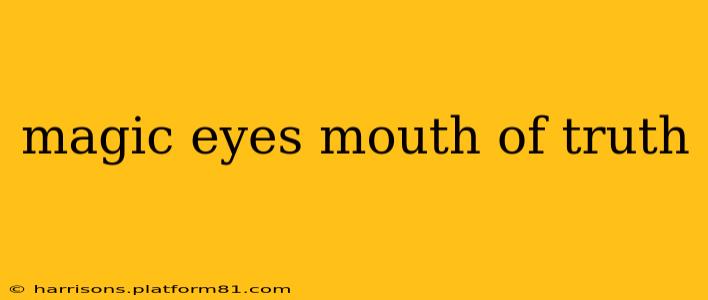The "Magic Eyes" and the "Mouth of Truth" represent fascinating intersections of illusion and reality, art and history. While seemingly disparate, both tap into our inherent fascination with the unexpected – whether a playful trick of the eye or a compelling piece of ancient lore. This article delves into both, exploring their origins, mechanics, and enduring appeal.
What are Magic Eye Pictures?
Magic Eye, also known as autostereograms, are images containing hidden three-dimensional shapes that become visible when viewed correctly. These aren't simple stereoscopic images requiring special glasses. Instead, they exploit the brain's ability to perceive depth by relaxing your eye muscles and focusing beyond the image plane. The hidden image emerges as your eyes converge and diverge naturally, effectively "crossing" your eyes slightly.
How do you see the hidden images in Magic Eye pictures?
The key is to relax your eyes and avoid focusing directly on the image. Instead, try to focus through it, as if peering past a window. The distance you need to focus is the key, often described as feeling a slight strain or blurriness before the 3D image pops out. Practice is crucial! Some people find it easier to hold the image at arm's length, while others prefer holding it closer. It’s a matter of finding the optimal viewing distance and eye focus for you.
Are there different types of Magic Eye pictures?
While the principle remains the same, the complexity and style of Magic Eye images vary greatly. Simple images might feature basic shapes, while more complex ones contain detailed scenes or objects. The complexity directly relates to the intricacy of the repeating pattern within the image. The more complex the pattern, the more challenging the image is to decipher.
The Mouth of Truth: Legend and Reality
The "Bocca della Verità" (Mouth of Truth) in Rome is a marble mask dating back to the 1st century CE. Legend claims that if someone places their hand in the mouth and tells a lie, the mask will bite off their hand.
Is the Mouth of Truth actually a mask?
Yes, the Mouth of Truth is widely believed to have been a cover for a public water fountain or a similar utility during Roman times. Its exact purpose remains debated, but its current location is in the church of Santa Maria in Cosmedin.
What is the history behind the legend of the Mouth of Truth?
The legend surrounding the Mouth of Truth's bite is likely a much later invention, likely emerging during the Middle Ages. It's a compelling narrative that has cemented its place in Roman folklore and popular imagination. The association with truth-telling and punishment for deception resonates with moral stories across cultures and time.
What is the Mouth of Truth made of?
The Mouth of Truth is carved from marble. Its size and detailed features contribute to its dramatic impact, enhancing its legendary reputation.
The Enduring Allure of Illusions and Legends
Both Magic Eye pictures and the Mouth of Truth showcase our fascination with the ambiguous and the unexpected. Magic Eye utilizes the natural limitations of our visual perception to create a delightful surprise, while the Mouth of Truth capitalizes on the human desire for truth and justice, blending fact and fiction into a powerful narrative. These seemingly unrelated phenomena speak to our enduring curiosity and delight in the surprising twists and turns of reality and imagination.
